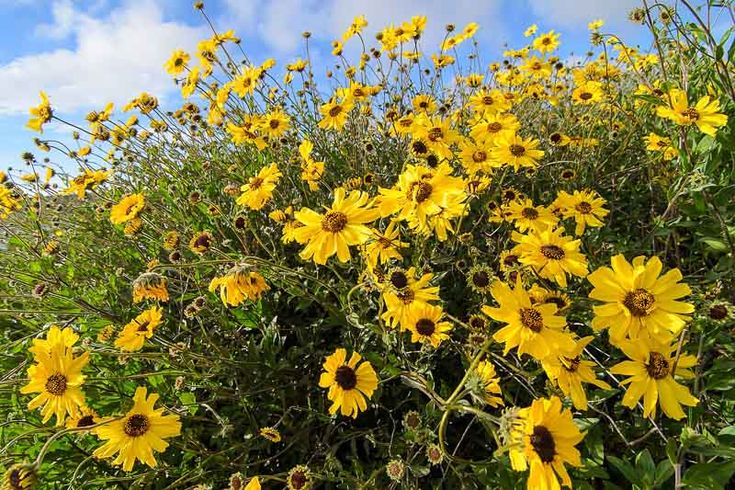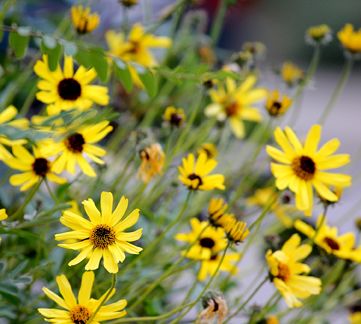Encelia californica

Encelia californica, commonly known as California Brittlebush, is a striking perennial shrub native to California and parts of the southwestern United States.
Renowned for its vibrant yellow flowers, silvery foliage, and drought tolerance, California Brittlebush adds beauty and resilience to arid landscapes.
In this comprehensive article, we will explore the botanical intricacies, habitat preferences, life cycle, ecological and cultural importance, conservation status, and care guidelines for Encelia californica.
Botanical Description
California Brittlebush belongs to the Asteraceae family and is characterized by its dense, rounded form, growing up to 3-5 feet tall and wide.
The plant features woody stems covered with grayish-green leaves that are narrow, lance-shaped, and coated with fine hairs, giving them a silvery appearance.
In spring and early summer, California Brittlebush produces an abundance of daisy-like flowers that range in color from bright yellow to golden-orange.
These showy flowers attract a variety of pollinators, including bees, butterflies, and other beneficial insects.
After flowering, California Brittlebush forms small, dry seeds that are dispersed by wind.
Habitat and Distribution
California Brittlebush is commonly found in dry, rocky slopes, desert washes, chaparral, and coastal sage scrub habitats throughout California, as well as in parts of Arizona, Nevada, and Baja California.
It thrives in well-drained, sandy or gravelly soils and is often seen growing alongside other drought-tolerant plants such as sagebrush, cacti, and desert shrubs.
California Brittlebush thrives in the arid conditions of its native habitat. It plays a crucial role in stabilizing soils, providing habitat for wildlife, and adding visual interest to the landscape.
Life Cycle and Phenology
California Brittlebush is a perennial plant with a relatively long life cycle. In favorable conditions, it can live for several decades, producing new growth each year from its woody base.
The plant typically blooms from late winter to early summer, depending on local climate conditions, with peak flowering occurring in spring.
During periods of drought or extreme heat, California Brittlebush may enter a period of dormancy, shedding leaves and conserving energy until conditions improve.
Despite its resilience to drought, California Brittlebush benefits from occasional irrigation during prolonged dry spells. This is especially true when grown in garden settings.
Ecological and Cultural Importance
California Brittlebush plays a vital ecological role in its native habitat, providing food and habitat for a variety of wildlife species.
The flowers attract pollinators such as bees and butterflies, while the seeds serve as a food source for birds and small mammals.
Additionally, California Brittlebush helps stabilize soils, reduce erosion, and conserve water through its extensive root system and drought-tolerant foliage.
Indigenous peoples have utilized California Brittlebush for centuries. They have used it for its medicinal properties, basket weaving, and dye-making from its flowers and leaves.

Caring for Encelia californica
Sunlight
Plant California Brittlebush in a location that receives full sunlight, as it thrives in bright, sunny conditions.
Watering
California Brittlebush is drought tolerant once established and requires minimal irrigation.
Water sparingly, especially during the plant's dormant period, to avoid root rot and other moisture-related issues.
Soil
Plant in well-drained, sandy or gravelly soil with good drainage.
Avoid heavy clay soils, as they can cause root rot and other problems.
Pruning
California Brittlebush requires minimal pruning to maintain its shape and remove dead or damaged growth.
Prune in late winter or early spring before new growth emerges.
Fertilizing
California Brittlebush is not heavy feeder and generally does not require fertilization.
If desired, apply a balanced fertilizer in spring, following the manufacturer's instructions.
Mulching
Apply a layer of organic mulch around the base of the plant. This helps retain moisture, suppress weeds, and insulate the roots from temperature fluctuations.
By following these care guidelines, you can cultivate healthy and vibrant California Brittlebush plants in your garden or landscape, contributing to the conservation of native plant species and the beauty of arid landscapes in California and beyond.
Whether grown for its ornamental value, ecological benefits, or cultural significance, California Brittlebush is sure to enhance any outdoor space with its vibrant flowers, silvery foliage, and resilient nature.
Leave a Reply
You must be logged in to post a comment.